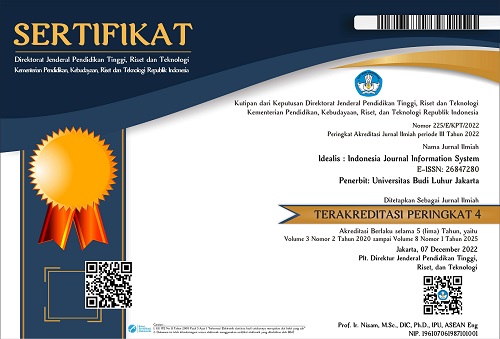DAMPAK PROGRESSIVE WEB APPLICATION (PWA) TERHADAP PENINGKATAN ENGAGEMENT DAN DWELL TIME PADA APLIKASI ECOMMERCE
Abstract
The advancement of digital technology encourages businesses to adopt e-commerce applications. However, the successful implementation of e-commerce applications still faces challenges in improving key indicators such as user engagement and dwell time. Progressive Web App (PWA) offers a technological solution with fast performance, high stability, and easy access across various devices, which is expected to address these challenges in e-commerce. While many e-commerce applications are available, not all of them have adopted PWA. Although PWA has the potential to address these challenges, its impact on engagement and dwell time has not been widely studied, particularly using a quantitative approach based on web analytics data. Previous research on PWA has largely focused on technical aspects and general user experience surveys. This study aims to measure the impact of PWA on user engagement and dwell time in e-commerce applications. It employs a quantitative method with a quasi-experimental approach, involving 50 participants divided into an experimental group (using PWA) and a control group (without PWA). Data were collected through Google Analytics and analyzed using the Shapiro-Wilk normality test and parametric analysis. The results show that PWA significantly increases engagement and dwell time, with pageviews rising by 48.79%, session duration increasing by 67.26%, and dwell time growing by 55.56%. These findings demonstrate that PWA not only enhances application efficiency but also improves user experience. This study contributes to the e-commerce literature and recommends the adoption of PWA to optimize user interaction and support sustainable business growth.
Downloads
References
[2] I. Hermawan, D. Reniawaty, P. Pramuditha, and M. I. Fusdsyi, “Pelatihan E-Commerce Untuk Mendapatkan Peluang Bisnis Bagi Mahasiswa Politeknik LP3I Bandung Pasca Pandemi Covid 19 (bekerjasama dengan UMKM Kirihuci sebagai pelatih e-commerce),” J. Adm. Bisnis, vol. 8, no. 1, pp. 96–106, 2022, [Online]. Available: http://jurnal.plb.ac.id/index.php/atrabis/article/view/932
[3] Y. Sugiarti, Y. Sari, and M. A. Hadiyat, “Peranan E-Commerce untuk Meningkatkan Daya Saing Usaha Mikro Kecil dan Menengah (UMKM) Sambal di Jawa Timur,” Kumawula J. Pengabdi. Kpd. Masy., vol. 3, no. 2, p. 298, 2020, doi: 10.24198/kumawula.v3i2.28181.
[4] W. Windihastuty, T. Fatimah, and S. Samsinar, “Perancangan Sistim E-Commerce Untuk Memperluas Pasar Hasil Olahan Sidat,” J. Mnemon., vol. 2, no. 1, pp. 17–21, 2019, doi: 10.36040/mnemonic.v2i1.46.
[5] H. Zhang and J. Dong, “Prediction of Repeat Customers on E-Commerce Platform Based on Blockchain,” Wirel. Commun. Mob. Comput., vol. 2020, pp. 1–15, Aug. 2020, doi: 10.1155/2020/8841437.
[6] S. Palinggi and E. C. Limbongan, “Pengaruh Internet Terhadap Industri E-Commerce dan Regulasi Perlindungan Data Pribadi Pelanggan di Indonesia,” Semin. Nas. Ris. dan Teknol., vol. 4, no. 1, pp. 225–232, 2020, doi: 10.30998/semnasristek.v4i1.2543.
[7] C. Yohana et al., “Pelatihan Digital Marketing Di Smkn 3 Jakarta,” Pros. Semin. Nas. Pengabdi. Kpd. Masy., vol. 2023, p. 2023, 2023, [Online]. Available: http://journal.unj.ac.id/unj/index.php/snppm
[8] A. A. Chandrawan, F. Al Huda, and K. C. Brata, “Pengembangan Aplikasi Edukasi Seksual untuk Remaja dengan Metode Kuis berbasis Progressive Web App,” J. Pengemb. Teknol. Inf. dan Ilmu Komput., vol. 7, no. 1, pp. 1–9, 2023, [Online]. Available: https://j-ptiik.ub.ac.id
[9] A. I. Putra, A. Putra Kharisma, and N. Yudistira, “Implementasi Progressive Web Application dan Framework CodeIgniter pada Sistem Informasi Lomba Karya Tulis Ilmiah Mahasiswa,” J. Pengemb. Teknol. Inf. dan Ilmu Komput., vol. 5, no. 9, pp. 3773–3783, 2021, [Online]. Available: http://j-ptiik.ub.ac.id
[10] M. Mena, A. Corral, L. Iribarne, and J. Criado, “A Progressive Web Application Based on Microservices Combining Geospatial Data and the Internet of Things,” IEEE Access, vol. 7, pp. 104577–104590, 2019, doi: 10.1109/ACCESS.2019.2932196.
[11] J. M. Santos-Gago et al., “Towards a Personalised Recommender Platform for Sportswomen,” Adv. Intell. Syst. Comput., vol. 930, pp. 504–514, 2019, doi: 10.1007/978-3-030-16181-1_48.
[12] F. Jorge, M. S. Teixeira, and R. Gonçalves, Trends and Innovations in Information Systems and Technologies, vol. 1161 AISC. 2020. doi: 10.1007/978-3-030-45697-9_54.
[13] S. Huber, L. Demetz, and M. Felderer, “PWA vs the Others: A Comparative Study on the UI Energy-Efficiency of Progressive Web Apps,” Lect. Notes Comput. Sci. (including Subser. Lect. Notes Artif. Intell. Lect. Notes Bioinformatics), vol. 12706 LNCS, no. May, pp. 464–479, 2021, doi: 10.1007/978-3-030-74296-6_35.
[14] K. A. Adhiguna, F. M. Rusli, and H. Irawan, “Building an ID Card Repository with Progressive Web Application to Mitigate Fraud based on the Twelve-Factor App methodology,” 2021 9th Int. Conf. Inf. Commun. Technol. ICoICT 2021, pp. 544–549, 2021, doi: 10.1109/ICoICT52021.2021.9527413.
[15] E. Hudianti, D. Maulana, and M. A. Nugroho, “Implementasi Progressive Web Apps Untuk Sistem Pengelolaan Potensi Desa Wisata Kali Opak Tujuh Bulan,” J. Inf. Syst. Manag., vol. 4, no. 2, pp. 86–90, Jan. 2023, doi: 10.24076/joism.2023v4i2.964.
[16] I. Mukhopadhyay and A. Ghosh, “Banking Transaction Considerations on Standardized Browser Architecture,” in Proceedings ofInternational Conference on Computational Intelligence, Data Science and Cloud Computing, Lecture Notes on Data Engineering and Communications Technologies, Springer Nature Singapore, 2021, pp. 635–644.
[17] E. Iskandar, R. C. Buwono, and S. O. N. Putri, “Implementasi Progressive Web Apps Pada Marketplace,” J. SAINTEKOM, vol. 12, no. 2, pp. 158–167, Sep. 2022, doi: 10.33020/saintekom.v12i2.265.
[18] M. Whittemore, S. Toubeau, Z. Griffin, and L. Deligiannidis, “ActiviX: Noninvasive Solution to Mental Health,” Adv. Comput. Vis. Comput. Biol. Trans. Comput. Sci. Comput. Intell., pp. 339–347, 2021, doi: 10.1007/978-3-030-71051-4_27.
[19] D. Purnomo Putro, A. Pramita Widyassari, and D. Salsabilla, “Collaboration of Progressive Web App (PWA) And Firebase Cloud Messaging (FCM) for Optimal Performance Mailing Software,” Int. Conf. Digit. Adv. Tour. Manag. Technol., vol. 1, no. 2, pp. 586–596, 2023, doi: 10.56910/ictmt.v1i2.126.
[20] H. Semuel, S. Wijaya, and C. Alianto, “Pengaruh Usability, Information Quality, Dan Interaction Quality Terhadap Web Revisit Intention Dan Purchase Intention Website Bali Tourism Board,” J. Manaj. Pemasar., vol. 15, no. 1, pp. 28–38, 2021, doi: 10.9744/pemasaran.15.1.28-38.
[21] Y. Tian, K. Zhou, and D. Pelleg, “What and How long: Prediction of Mobile App Engagement,” ACM Trans. Inf. Syst., vol. 40, no. 1, pp. 1–38, 2022, doi: 10.1145/3464301.
[22] Z. A. M. Tanjung, D. S. V. L.S, M. B. S. Depari, E. Indra, D. A. Akbari, and R. E. Edison, “Analisis Perbedaan Atensi Visual Customer Shopee Terhadap Produk Flash Sale Dengan Produk Normal Berbasis Eye Tracking,” J. Tekinkom (Teknik Inf. dan Komputer), vol. 7, no. 1, pp. 441–450, 2024, doi: 10.37600/tekinkom.v7i1.1368.
[23] Z. Epstein, H. Lin, G. Pennycook, and D. Rand, “Quantifying attention via dwell time and engagement in a social media browsing environment,” 2022, doi: https://doi.org/10.48550/arXiv.2209.10464.
[24] J. Sauro and J. Lewis, Quantifying the User: Experience Practical Statistics for User Research, vol. 11, no. 1. United States of America: Elsevier, 2012.
Copyright (c) 2025 Dwi Purnomo Putro, Joko Suprianto, Puput Eka Suryani

This work is licensed under a Creative Commons Attribution-ShareAlike 4.0 International License.














.png)

